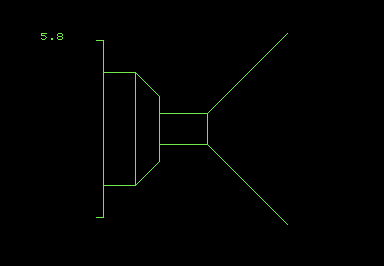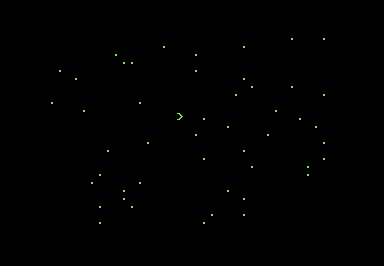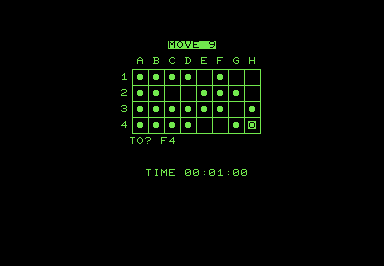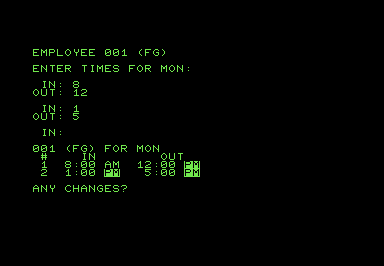CURSOR #13 – August/September 1979
“I have the pleasure of reviewing a lot of programs submitted by
CURSOR subscribers. The submitted material runs the full gamut from absolute trash to very
well written programs. What excites me is that some of our best submissions come from folks
who didn't know how to spell computer a few weeks or months ago. We get letters such as
‘...this is the second program I've ever written...’, and sometimes find a
fresh and well thought-out program idea.”
—Excerpted from A Cursory Glance, Issue #13

COVER
Author: Chuck Bond
Original file name: COVER13
PRG file: cover13.prg
Fish! This month's cover is charming. Two PETSCII fish swim back and forth across the screen, occasionally blowing bubbles. The water line at the top of the tank is animated with rolling waves. Excellent work here.
Pressing SPACE takes you to the
table of contents for the issue.

RATRUN
Author: C. T. Nadovich
Original file name: RATRUN
PRG file: ratrun.prg
These 3D maze things were always cool. RATRUN places you in a randomly-generated
maze, where you are the "rat" with the goal of finding your way to the cheese. Your position
in the maze is drawn from a first-person perspective, and you're given a little number in the
upper left corner that indicates the as-the-crow-flies distance to your goal. This number can
be deceptive, though—you may find yourself one tile away from the cheese but on the wrong
side of a wall in a dead-end passage. The screen refresh will feel a bit slow to modern players
but it's actually not too bad considering that the entire game is written in BASIC.

CARS
Author: John Grove
Original file name: CARS
PRG file: cars.prg
This simple application tracks recurring expenses for up to three vehicles. The flyer admits
that "CARS is an example of a program that could have been much nicer if it was
written for a 16K system," (instead of 8K) which is absolutely true. I've looked over the listing,
and while there are a few opportunities to save memory, I don't think you can squeeze out enough
RAM to make this program user-friendly. The UX is subpar, even for 1979: the prompts are sparse,
validation is weak, and options are limited. In these days of gigabytes of RAM, it's easy to forget
that the memory limitations of these early home computers were really restrictive. While it's true
that the programmer could have done a lot with an extra 8K of RAM, a significant portion of PET
users would not have been able to run a larger program. CURSOR subscribers had been asking
for more practical programs to be included on the tapes, but I'm not sure that programs like
CARS were good value for their money.

FERRY!
Author: Dr. John J. Matarella
Original file name: FERRY!
PRG file: ferry.prg
In FERRY, you move your ship (>) from the left side of
the screen to the right while dodging a field of upwardly-scrolling dots. On the
easiest level, you start near the top of the screen, which gives you a lot of time
to see what's coming; on higher levels, you begin closer to the bottom, making your
journey significantly more difficult. "Hope you have CB2 sound!!!" chirps the flyer,
but I found the sound rather irritating.

LEAP
Author: Glen Fisher and Sheila Dolgowich
Original file name: LEAP
PRG file: leap.prg
LEAP is a variant of the
peg solitaire
game played on a non-standard 4x8 rectangular board. You choose which cell is empty
at the start of the game. I did a little research and learned that the 4x8 board belongs
to a generalized class of solvable boards, so if you want to take this one on, you
should aim to finish with only one peg remaining.

TCARD
Author: Glen Fisher and Herb Sandy
Original file name: TCARD
PRG file: tcard.prg
TCARD is an employee time-tracking application with some clever ways to input
and validate time "punches" in and out. The program is credited to Glen Fisher, and the BASIC
listing has a line that says REM INSPIRED BY A PROGRAM BY HERB SANDY. I'm guessing
that means that Herb Sandy submitted a program to CURSOR and Fisher had to put it through
substantial refactoring to get it ready for publication.
I'm not convinced that anybody would have run this program as-is, but someone looking to write their own time-tracking application in BASIC would find some great ideas to steal in Fisher's code.
